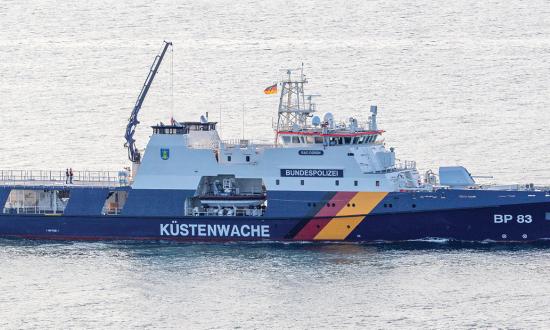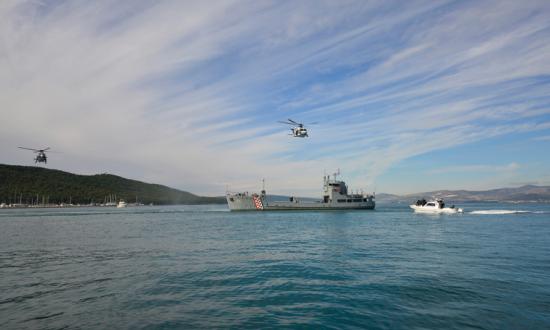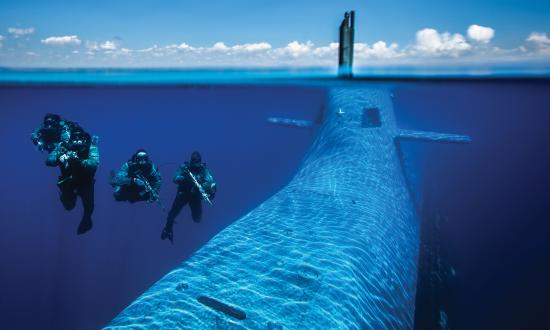Between 1997 and 2016, many Germans tuned in for Küstenwache (Coast Guard), an intense, 45-minute program on public television featuring action and drama on the Baltic Sea. In 299 episodes, the brave members of the German Coast Guard fought drug smuggling, toxic waste dumping, illegal fishing, and even kidnapping, extortion, and murder. For all the show’s bravado, however, it glossed over a fundamental issue: Germany does not have a unified Coast Guard. It is an amalgam of several federal and state agencies. As the Coast Guard’s stature grows with the deployment of highly capable Potsdam-class offshore patrol boats and rising demands for international operations on distant shores, it is time to discuss its opportunities and challenges.
A Unique Evolution
All over the world, coast guards work under different legal systems and organizational structures. Their missions range from military and police functions to search and rescue (SAR), protection of natural resources, border protection, customs, and aids to navigation/marine safety. In some countries, navies take on coast guard functions. In other countries, gendarmeries or other police units assume the role.
The German approach is different. In 1994, maritime services and units of different federal ministries were directed to form the German Coast Guard, in part to save money by creating synergies following German reunification. However, every ministry had to retain its respective responsibilities, logistics, training, and crewing. Different maritime tasks are assigned to different ministries, and there is a conscious division between domestic and international security.
For the Coast Guard, this means cutters are developed and crewed according to function. For example, those involved in border protection and maritime security are manned and maintained by the Federal Police (Bundespolizei). Fisheries protection vessels are crewed by members of the Federal Department of Nutrition and Agriculture, and customs collection cutters by the Federal Customs Service (Zoll). But within the cutters, there is more cross-pollination and integration than meets the eye, especially with regard to command and control and crewing.
In 2007, the two integrated Coast Guard Centers—one for the Baltic Sea and another for the North Sea—were merged into the Maritime Safety and Security Centre (MSSC) in Cuxhaven. The MSSC is the communication and cooperation network of the operational forces of the federal government and the coastal states. All the authorities responsible for maritime security and facilities in this high-performance network have been united, including:
• Federal Police
• Federal Customs Administration
• Federal Office for Agriculture and Food
• Federal Waterways and Shipping Administration
• German Navy
• German Waterways Police of the five coastal states
• Central Command for Maritime Emergencies
The heart of the MSSC is a large situation room, the Joint Emergency Reporting and Assessment Centre Sea (JERACS). JERACS is responsible for the work of all partners to ensure safety and security at sea. Around the clock, 365 days a year, employees of the maritime security authorities work closely together in the center.
This pooling of expertise and allocation of responsibilities enable greater flexibility and flow of information, for optimal monitoring of shipping along the German coast and at the seaward port entrances. In addition, team members coordinate the missions of seagoing units and airborne vehicles and provide situational assessments.
Search and Rescue
The SAR Service is run mainly by volunteers on behalf of the Ministry of Transport, which depends on donations to maintain its fleet of lifeboats and seagoing rescue cutters, a small cadre of professional mariners, and the Maritime Rescue Coordination Centre (MRCC) in Bremen. The MRCC works closely with the MSSC; JERACS coordinates the patrol activities of all assets.
Any information about a situation at sea that falls under the jurisdiction of one of the entities represented in the MRCC either is immediately processed by a watchstander or a meeting of all duty officers is called to assess the situation. In a running situation, the center coordinates assets, gathers information, and establishes information channels to external partners, such as neighboring countries or the merchant marine. Operational decisions are made on-scene by the responsible authority’s ship commanders. This somewhat unusual system has proved its effectiveness in daily duty as well as in critical situations.
In 2010, the Lisco Gloria, a ferry bound for Lithuania, caught fire. JERACS immediately ordered all available assets on scene, and in close cooperation with the MRCC, all 237 passengers were rescued by the Federal Police offshore patrol vessel (OPV) Neustrelitz. The fire was extinguished days later, but the ship had to be written off.
The OPV 86s
The largest law enforcement organization within the Küstenwache is the Federal Police. This force of approximately 39,000 police officers is tasked under the Federal Ministry of the Interior. A small maritime component of about 600 officers—the Bundespolizei See—operates six OPVs, five coastal patrol boats, and various shore-based units, including investigation and training units. The backbone of the seagoing fleet is the new OPV Type 86. (See “Combat Fleets,” p. 93.)
The Bundespolizei procured three modern OPVs in 2016: the Potsdam, Bamberg, and Bad Düben. The “86s,” as they are commonly called, are maritime multitools. A hatch in the helo deck allows loading up to five mission-specific standard containers, such as additional accommodations, diving gear, workshops, or sanitary facilities. A hospital with a state-of the-art intensive care unit is easily accessible from the boat deck. A situation room with communication gear enables the ship’s crew to command and control various operations, such as border protection missions, special operations, or large-scale SAR events.
The vessels are ideal platforms for supporting special police forces and versatile assets in all maritime law enforcement scenarios. With these ships, the Bundespolizei is moving forward to meet the new challenges in a changing maritime world of the 2020s.
Maritime Law Enforcement
In the early 1990s, the Bundesgrenzschutz See, the predecessor organization of the Bundespolizei See, received its first call for an international police mission. After a short preparation, crews and boats were deployed to the Danube River to help enforce the international embargo against Serbia and Montenegro during the Balkans conflict. Since then, maritime police officers have served worldwide as trainers and advisors to coast guards of countries affected by maritime crime, such as human trafficking and piracy. Specialists were sent to the Middle East, Africa, the Balkans, and South America. As the European Union (EU) expanded in the early 2000s, German maritime police officers were deployed to candidate states to harmonize the former Eastern bloc police forces with EU standards.
On a regional level, Germany participates in international networks such as the Baltic Sea Region Border Control Cooperation. Direct and quick exchange of information among the participating countries’ maritime situation centers is routine, and cooperation and connections among the region’s coast guards has tightened, with standardized operations, training, and exercises.
Crisis Mode
In 2015, Europe faced a major crisis in the Mediterranean. With the war in Syria, the rise of the Islamic State, and a deteriorating political situation in North Africa, millions of refugees and other migrants tried to reach Europe. The EU’s so-called Dublin regime stipulates that the European countries where asylum seekers first enter are responsible for processing the asylum requests. Italy, Spain, and Greece, having to bear the brunt of the migrations, called for European solidarity and support. The European Border and Coast Guard Agency, better known as FRONTEX, reinforced the coast guard units with an ad-hoc deployment of additional land, sea, and air assets.
For the Poseidon Rapid Intervention in the Aegean, FRONTEX requested the Bundespolizei See to contribute two coastal patrol boats (CPBs). In March 2016, the two CPBs, each with two crews and one command and support element, started patrolling the strait between the Aegean island of Samos, Greece, and the Turkish coastline. They immediately found themselves in the midst of a humanitarian crisis. The German sailors evacuated overcrowded migrant boats, provided first aid to suffering people, chased armed smugglers through the night, and rescued families suffering from hypothermia from knife-edged rocks. Since the beginning of Operation Poseidon, the two CPBs have rescued more than 6,300 migrants from distress at sea.
Originally planned as a three-month deployment, the mission is still ongoing. More than 2,500 patrols had been completed by the end of 2020. The effectiveness of the German CPB patrols keeps them in Greek waters today. Their crew members include personnel not only from the Bundespolizei, but also from other German maritime authorities such as the Federal Customs Service and the state police forces. The Koninklijke Marechausse, a military law enforcement service of The Netherlands, also is supporting the German crews with well-trained personnel, and the Hellenic Coast Guard deploys liaison officers on the CPBs.
As a consequence, the German CPBs in this FRONTEX operation are both international and cross-functionally crewed assets. Crew members with different professional backgrounds and origins bring a wide range of experience and knowledge to the deckplates. CPB officers-in-charge can leverage this expertise depending on the situation and rules of engagement, allowing for multidimensional approaches to tactical situations at sea. This could be a role model for other operations, when the demand for specialized personnel cannot be covered by one organization or country.
The German Coast Guard has a significant role to play in 21st-century maritime security operations, in the Baltic and North Seas or wherever the political will mandates. Its disparate and complex composition makes it uniquely capable of adapting to a changing maritime environment. It leverages its diverse personnel to complete highly complex missions, ranging from gray zone operations in the Baltic to politically sensitive migration operations in the Mediterranean. With larger and more capable vessels, the Federal Police is likely to be an increasingly vital player on Europe’s troubled seas.








